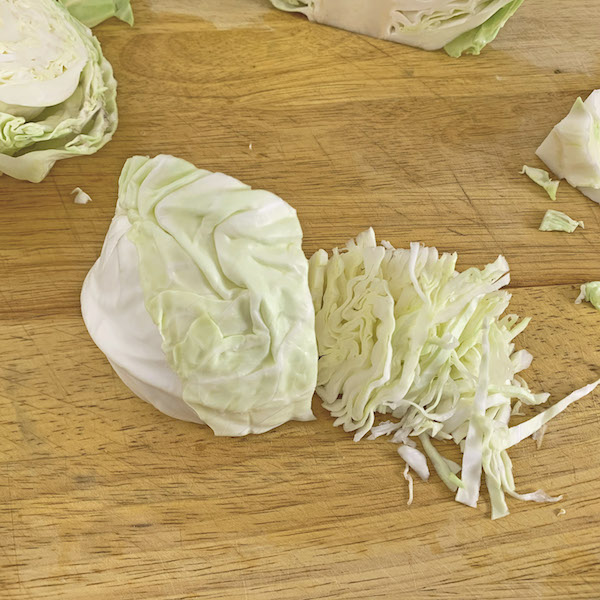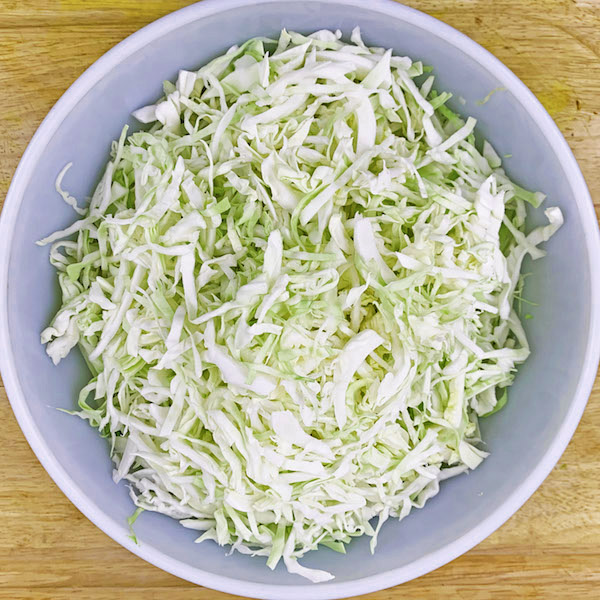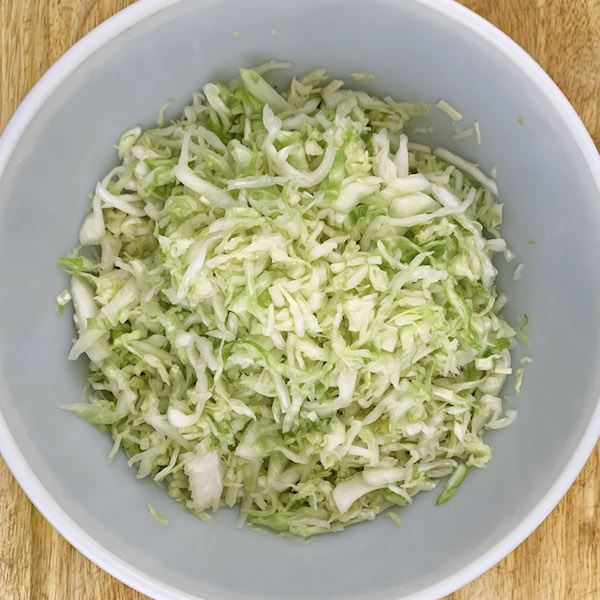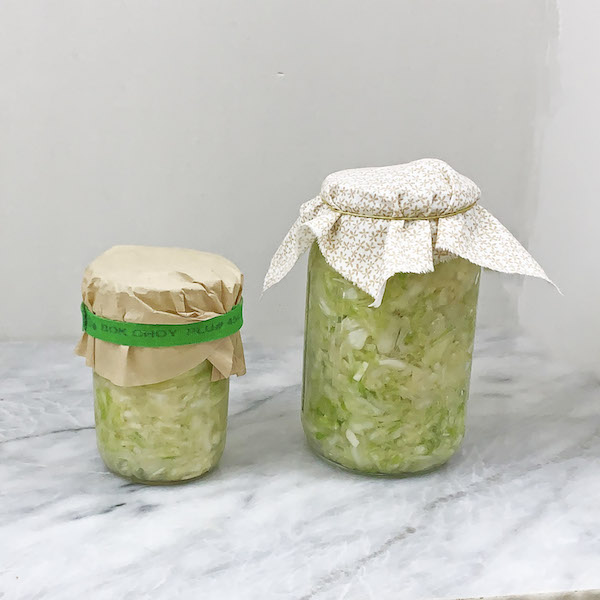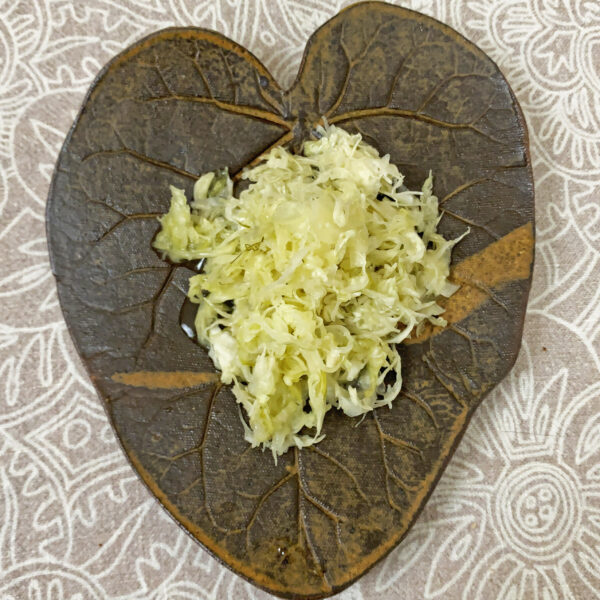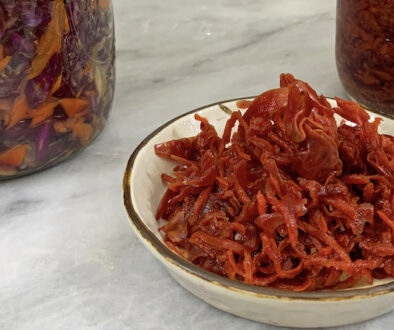Homemade Sauerkraut
Any time you have a bit of time is a great time to make sauerkraut.
Live homemade sauerkraut is full of enzymes, probiotics and nutrients.
The enzymes help us break down our food and the probiotics help us digest them. Together they are great for supporting better gut health. This in turn helps support our immune system.
It is so wise to have a spoonful of fermented food (like live sauerkraut) with your meals to support better health.
This recipe is made to be kept in the frig. (as opposed to canning) to preserve the live probiotic benefits.
Use organic everything when you can.
Before you begin, remember to practice basic food safety. Do not make sauerkraut if you are sick or coughing. Use well washed hands free of polish or lotion (or wear gloves). Hair tied back. All utensils and surfaces used need to be very clean.
Basically you peel off the put tough leaves of the cabbage. Take out core and shred the cabbage. You can cut it by hand or use a mandolin or a food processor.
Mix with desired amount of salt. I recommend good quality sea salt (not pink).
Start with a scant tsp. of sea salt per pound of cabbage.
No scale – no problem. Check your grocery receipt for the weight or pop on the scale at the market and make a note.
If you forget just start with a little less than a Tbs. of sea salt per medium sized cabbage. If after you have massaged that in really well and there is not enough liquid coming out of the cabbage you add a little more.
(You can always add a little more salt, but you cannot take it out once added.)
Once the salt has broken down the cabbage enough to squeeze a thin stream of liquid out you pack into jars.
If I am making a large amount of kraut( to give to family and friends) I would opt for fermenting in a large jar for a better fermentation result. Then I break it down to smaller jars when it time to go in the frig.
I have recently learned how to make a cabbage hat to cover the kraut which is an awesome idea.
Simply take one the clean, outer, unused leaves and cut to the size to cover in cabbage inside the jar. Press down on top of the cabbage until the liquid rises above the leaf.
If you are using a small necked canning jar this should sufficient with out adding a weight on top.
If you are using a wide mouth jar a weight is good idea.
For a weight you can use a store bought weight or a smaller jar inserted in.
You can also make your own pickle ( kraut)weight with rocks.
Keeping in mind the size of the jar opening look for an even shaped rock (of a size that will fit into your jar) with a smooth surface from a ‘clean’ place outdoors.
Bring your new kitchen tool inside and scrub and wash thoroughly with detergent. Rinse well. Then set in a pan and cover with water by an inch or two. Bring to a full boil. Reduce heat and simmer for 10 minutes. Cook it longer if you want.
Drain water and let cool. Say hello to your new pickle rock.
Once you have your cabbage salted, pressed into a jar, weighed down you want to cover it.
While the cabbage ferments gasses will release and bubble up.
You want to cover the jar in something to let the gasses out but keep any dust (or) from getting in.
A small piece of cloth is great. I have also used a coffee filter in a pinch. You could also use a sprout jar screen lid with cloth or paper towel.
Secure with a string, a rubber band, a twist tie,,,use what you have on hand.
Set jar on a tray or plate.
If you can, it’s its a good idea to ferment your pickles in the same spot. Pick a quiet corner with air circulation, out of any direct sunlight.
Check your kraut every few days. As it bubbles up and weeps you can change the cover and clean the tray.
After a week try a little taste. Never double dip a fork in live kraut as you may introduce bacteria that could change or spoil the batch.
Most people like it around the 2 week range but some like it fermented longer. Suit your self.
When it has fermented to the right stage for you, clean the jar rim and outside if needed. Seal with a jar lid and put in frig.
Its good to eat a spoon full or two a day but remember that the salt you put in didn’t go away even though you may not be able to taste it anymore. A little goes a long way.
Have fun, and when you get some experience try different recipes.
Happy fermenting!
Homemade Sauerkraut
prep time 15 to 20 minutes
ferment time 1 to 4 weeks
yield – 1 quart (plus a little more depending on size of cabbage)
Ingredients:
1 medium size green cabbage – about 3 1/2 lbs.
2 tsp. sea salt plus more as needed
Directions:
Remove tough outer leaves and wash cabbage. Cut into quarters and cut out the core.
Shred with a knife, mandolin, or food processor(use the thin slicing blade for the food processor for a similar result).
Mix in 2 tsp. sea salt for a 3 lb. cabbage. Mix thoroughly. Then massage (about 5 minutes) the salt into the cabbage to draw the liquid out. It is ready when you can squeeze a handful and a tiny stream out juice comes out.
You can add a little more salt if you are not getting enough liquid.
Pack the cabbage tightly (not too tightly) into a quart jar. Press down so the cabbage juice covers the cabbage. Put on the cabbage hat if using. Put a weight (if using) on the cabbage or cabbage hat.
I like to use both.
Cover jar with a cloth or other breathable, protective cover.
Set in quiet corner, on a tray, away from direct light and activity.
Check your jar(s) every day or so. Sometimes the kraut will bubble up as it ferments it may weep over the sides.
You may want to replace the cover and clean the tray. If any mold appears remove with any thing that it touched.
Let ferment for 1 to 4 weeks. When you are satisfied, clean jar rim and put a seal with a jar cover.

